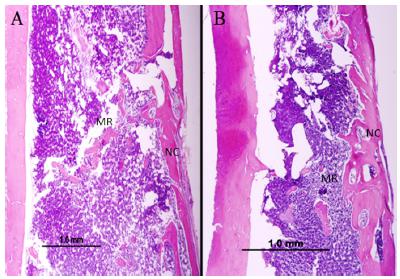Abstract
Purpose:
To investigate if the inorganic bovine bone matrix changes the bone formation in rats submitted to inhalation of cigarette smoke.
Methods:
Twenty Wistar rats were divided into two groups: Cigarette Clot Group (CCG), which in the inhalation chamber received the smoke of 10 cigarettes, 3 times a day, 10 minutes, for 30 days and had the surgical cavity filled by clot; Cigarette Biomaterial Group (CBG), submitted to the same inhalation technique but with the cavity filled by biomaterial.
Results:
In CCG there was a significant difference of new bone tissue in the analyzed periods (15 and 45 days), and in 15 days, there was 4.8 ± 0.42 of bone formed and 11.73 ± 0.59 (p <0.05) in 45 days. The CBG also showed a significant difference between the periods of 15 to 45 days, being respectively 6.16 ± 0.30 and 11.60 ± 0.61. However, when the groups were compared, within the same analyzed periods, a significant difference was observed only in the period of 15 days, with the new bone percentage being greater in the CBG.
Conclusion:
The bone matrix acted as an osteoinductive biomaterial, biocompatible and aided in the repair process, mainly in the initial period of recovery.
Key words:
Biocompatible Materials; Bone Regeneration; Bone Transplantation; Heterografts; Smoking; Rats.





